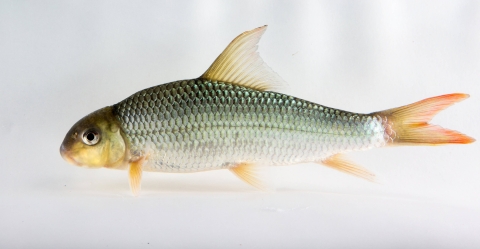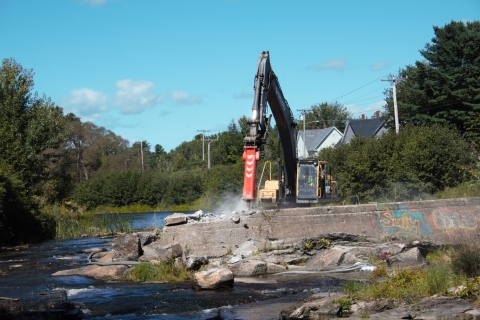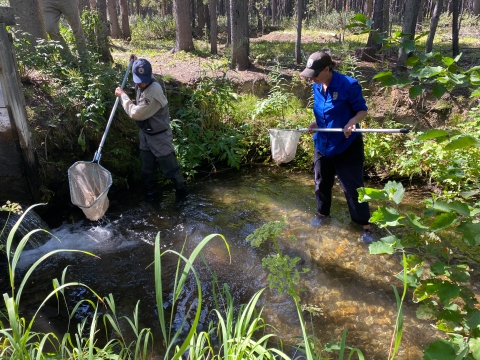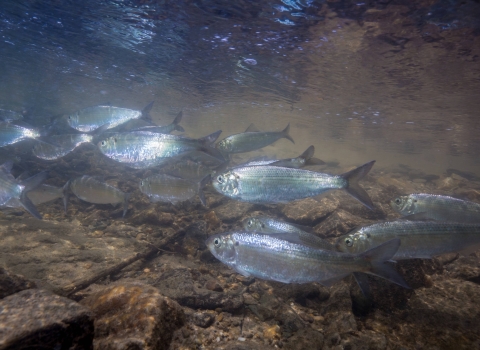Across the country National Fish Passage Program projects funded by the Bipartisan Infrastructure Law Bipartisan Infrastructure Law
The Bipartisan Infrastructure Law (BIL) is a once-in-a-generation investment in the nation’s infrastructure and economic competitiveness. We were directly appropriated $455 million over five years in BIL funds for programs related to the President’s America the Beautiful initiative.
Learn more about Bipartisan Infrastructure Law will help restore rivers, protect wildlife, support communities, and improve climate resilience.
In 2023, the U.S. Fish and Wildlife Service announced 22 states will receive $35 million to support 39 projects that will address outdated or obsolete dams, culverts, levees and other barriers fragmenting our nation’s rivers and streams.
Around the world, millions of barriers are fragmenting rivers, blocking fish migration, and putting communities at higher risk to flooding. Improving fish passage is one of the most effective ways to help conserve vulnerable species while building safer infrastructure for communities and improving climate resilience. The Bipartisan Infrastructure Law (BIL) provides a once-in-a generation opportunity to invest in climate resilient infrastructure, healthy rivers and streams, and abundant fisheries. The 2023 projects represent the second year of a five-year commitment and build on the 40 projects announced last year.
This year, there are 23 projects that have Tribal involvement and nine projects that are Tribally-led, where funding is going directly to those awarded Tribes. Many of these projects will help with conservation efforts for threatened or endangered species.
Ela Dam Removal (North Carolina), $4 million – This project will reopen nearly 550 miles of habitat to several sensitive and rare aquatic species, including sicklefin redhorse, a vital food source for Tribal ancestors of the Eastern Band of Cherokee Indians, and Appalachian elktoe, a federally endangered freshwater mussel.
Restoring Access to Tyonek Creek (Alaska), $780,000 – This project will complete a 10-year, multiagency effort to remove all barriers in the Tyonek Creek watershed, near the Native village of Tyonek, opening a total of 31 miles for subsistence salmon populations.
Talbot Mills Dam Removal on the Concord River (Massachusetts), $1,043,951 – This will be the largest dam removal in the history of the state, reopening 135 stream miles to anadromous species that have not had passage since the 1700s.
Maple River Reconnection (Michigan), $1.9 million – This project will protect surrounding agricultural land from flooding events and support the cultural restoration and expansion of indigenous Manoomin (wild rice) crop, which is important to the Little River Band of Ottawa Indian Tribe.
FY23 National Fish Passage projects with funding from Bipartisan Infrastructure Law.
Construction has already started or completed on many of the 40 Bipartisan Infrastructure Law-funded fish passage projects announced last year in 2022.
Sabattus River Restoration (Maine) – This project removed the Upper Town Dam from the Sabattus River, a tributary to the Androscoggin River. The second dam removal is scheduled for later in 2023. These efforts are expected to reopen 2,309 acres of lake and pond habitat and 25 miles of river and stream habitat for alewife, blueback herring, American shad, federally endangered Atlantic salmon, and American eel.
Gustavus Alaska Landscape Scale Watershed Restoration (Alaska) – This project removed the last culvert impeding fish passage and replaced it with a timber bridge, completing the effort to provide unimpeded access to six miles of habitat for Pacific salmon, Dolly Varden Char, and Coastal Cutthroat Trout. The project also fixed the traffic safety issue which came along with a narrow road with no guard rails, unstable banks, and a failing embankment.
Upper Clark Fork Fish Passage for Bull Trout and Westslope Cutthroat(Montana) – This project, which is located on the traditional lands of the Salish and Shoshone-Bannock Indigenous peoples, supports economic development and creates stable diversions to help buffer the local community against potential loss of crops due to climate change climate change
Climate change includes both global warming driven by human-induced emissions of greenhouse gases and the resulting large-scale shifts in weather patterns. Though there have been previous periods of climatic change, since the mid-20th century humans have had an unprecedented impact on Earth's climate system and caused change on a global scale.
Learn more about climate change .
Potomac Headwaters Fish Passage Restoration (West Virginia, Virginia, and Maryland) – This project is implementing up to 17 fish passage barrier removal projects, including dam removals and road-stream crossing replacements, to reconnect over 195 miles of habitat for brook trout and American eel in the headwaters of the Potomac Watershed.
The National Fish Passage Program: Leaders in Building Bridges and Fostering Connections
The National Fish Passage Program is a national leader connecting watersheds and people. The program has decades of experience implementing infrastructure projects with partners. Under BIL we are bringing that experience to bear to foster collaboration between federal agencies, Tribes, states, and non-profit partners.
Since 1999, the program has worked with over 2,000 local communities, Tribes, and private landowners to remove or bypass over 3,400 barriers to fish passage and reopen access to over 61,000 miles of upstream habitat for fish and other animals. Staff have expertise in fish migration and biology as well as financial, engineering, and planning assistance to communities, Tribes, and landowners to help them remove barriers and restore rivers for the benefit both fish and people.
The rivers, streams, and coastal systems of North America once supported vast annual runs of fish such as Pacific salmon, American shad, blueback herring, Pacific lamprey and American eel. These species and many others, including some at-risk and listed species, depend on connected streams and high-quality habitat to survive. The U.S. Fish and Wildlife Service and the National Fish Passage Program are committed to reconnecting rivers for the benefit of all.
Federal Interagency Fish Passage Portal
The Federal Interagency Fish Passage Portal is a resource for anyone who needs information, funding, or technical assistance to improve fish passage and aquatic connectivity projects. We provide landowners and public lands managers the tools they need to access fish passage resources across the federal government.
The Fish Passage Portal will be a living repository of the best resources and information from across the federal government. It will be updated regularly to meet all your project needs from planning, to funding, to implementation. Rather than having to scour federal websites for the information you need, the portal will provide the information you need in one free and easy to access location.






